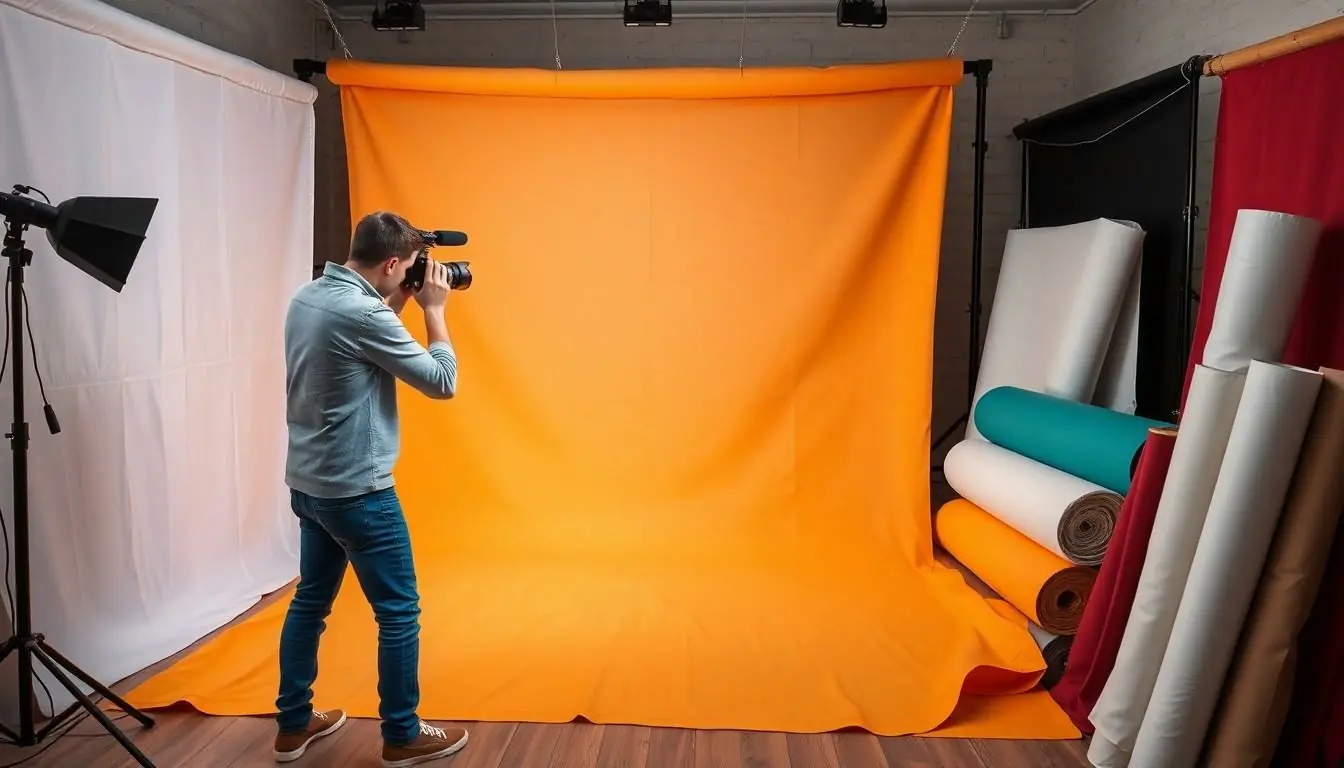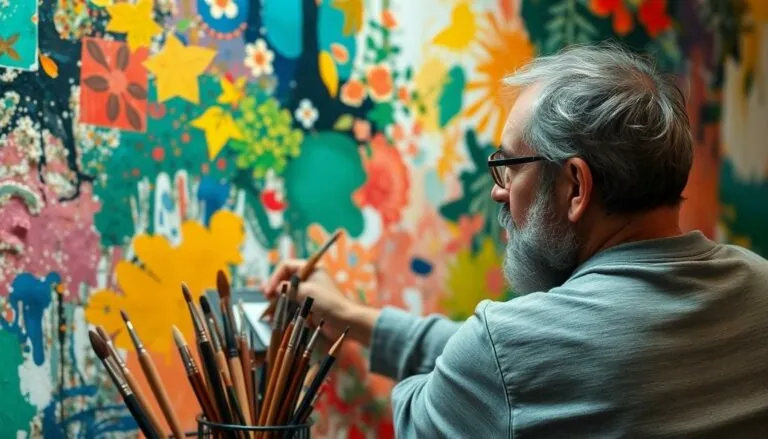Table of Contents
ToggleIn the world of product photography, the backdrop can make or break a shot. Imagine showcasing a sleek gadget against a cluttered kitchen or a stunning dress draped over a pile of laundry. Yikes! Choosing the right backdrop is like finding the perfect wingman; it elevates your product and creates a visually appealing story.
Overview of Product Photography Backdrops
Product photography backdrops play a crucial role in showcasing items effectively. Various backdrop types cater to different product requirements. Solid colors, for instance, offer a clean and professional look, emphasizing the product without distractions. Textured surfaces add depth, enhancing visual interest while remaining subtle.
Natural materials, such as wood or fabric, create an organic feel. These options work well for lifestyle products, resonating with audiences seeking authenticity. Reflective surfaces, like acrylic or glass, introduce a modern aesthetic and can add dynamic lighting effects.
Digital backdrops provide versatile solutions, allowing easy adjustments in post-processing. This flexibility supports various themes and campaigns without the need for physical changes. Selecting the right backdrop contributes significantly to branding, as it reinforces a company’s visual identity.
The scale of the product also influences backdrop choice. Smaller items benefit from minimalistic setups, directing focus solely on the product. Conversely, larger products may require more elaborate backdrops to provide context and create a relatable environment.
Lighting complements backdrops and helps enhance the overall quality of the images. Proper light usage can highlight textures and colors found in both the product and backdrop. Additionally, thoughtful pairing of products with backdrops enables cohesive storytelling through visuals.
Ultimately, the choice of backdrop shapes the viewer’s perception. Understanding the product’s intrinsic qualities and the desired message guides the selection process. Creating stunning product images requires consideration of backdrops as fundamental elements, not as secondary afterthoughts.
Types of Product Photography Backdrops

Choosing the right type of backdrop can enhance the effectiveness of product photography. Various options are available, each serving unique purposes and aesthetics.
Fabric Backdrops
Fabric backdrops offer versatility and texture. Options such as muslin and canvas create a soft and inviting atmosphere that can complement products well. These materials easily absorb light, reducing glare and providing even illumination. Wrinkle resistance varies; some fabrics drape elegantly, while others require pressing. Additionally, fabric backdrops can be printed with custom designs, allowing for personalized branding. They typically fold easily for storage and transportation, making them ideal for on-location shoots.
Paper Backdrops
Paper backdrops provide a smooth, clean look ideal for product photography. Available in rolls, these backdrops offer a wide range of colors and textures. They are great for straightforward setups where minimal distraction is crucial. Paper is lightweight and easy to transport, making it suitable for studio environments or mobile shooters. However, they can be prone to tears and scratches, so careful handling is essential. For a cost-effective solution, these backdrops can easily be replaced as needed.
Vinyl Backdrops
Vinyl backdrops are known for durability and easy maintenance. These materials are water-resistant, making them suitable for products that may create a mess. Vinyl can also handle harsh lighting without reflecting glare, allowing for crisp images. Available in various finishes, options include matte and glossy, catering to different aesthetic preferences. Heavy-duty vinyl backdrops prevent creasing and can be wiped clean, enabling repeated use. They work well for both studio and outdoor shoots, adding versatility to any photography setup.
Choosing the Right Backdrop
Selecting an appropriate backdrop greatly influences product photography’s effectiveness. A careful choice creates a visual narrative that enhances product appeal.
Color Considerations
Color selection directly affects the viewer’s perception of a product. Neutral colors like white or gray provide a clean canvas that makes products stand out. Bright or bold colors can convey specific emotions or themes when aligned with brand identity. Consider the product’s hues to ensure they complement the backdrop rather than clash. Subtle variations in color can also add interest without distracting. Using a color wheel can help identify harmonious combinations for cohesive imagery.
Texture and Material
Texture and material play critical roles in setting the atmosphere of product photos. Soft fabrics, such as muslin or velvet, lend warmth and depth to an image, creating an inviting feel. Smooth surfaces, like paper or vinyl, emphasize clarity and professionalism, making them suitable for commercial product shots. Conversely, natural textures, like wood or stone, add an organic touch that appeals to lifestyle branding. Assess the product’s nature to determine which texture enhances its attributes while avoiding overwhelming visual elements.
Setting Up for Success
Creating stunning product photography starts with proper setup. Achieving the right ambiance and arrangement can elevate visual appeal significantly.
Lighting Techniques
Understanding lighting techniques is vital for optimizing product images. Natural light provides a soft, diffused effect, ideal for showcasing textures and colors. Using diffusers or reflectors enhances this quality, distributing light evenly. Artificial lights, like softboxes or LED panels, allow for controlled brightness and heat management. Position lights at various angles to minimize harsh shadows, enhancing the product’s details. Experimenting with lighting setups enables photographers to find the striking balance that best complements the chosen backdrop.
Composition Tips
Composition dictates how viewers perceive the product. Centering the product in the frame highlights its features, while placing it off-center adds interest and dynamic appeal. Incorporating negative space allows the product to breathe, guiding focus without distraction. Creating layers with foreground and background elements establishes depth, enhancing the overall atmosphere. Utilizing the rule of thirds often improves visual balance, drawing the eye to crucial details. Each composition choice contributes significantly to the narrative, enhancing the product’s story through thoughtful arrangement and perspective.
Popular Brands and Products
Numerous brands specialize in backdrops for product photography. Savage Universal stands out for its wide range of paper backdrops, known for their quality and variety of colors. Another popular choice is Kate, offering fabric backdrops that provide texture while remaining easy to transport.
Neewer offers a diverse selection of vinyl backdrops, known for their durability and resistance to spills, perfect for various shooting environments. For those seeking digital options, Backdrop Express provides customizable digital backdrops suitable for various themes.
In terms of accessories, Lastolite’s portable reflectors enhance lighting quality, making them a valuable addition to backdrop setups. Each brand’s products cater to different photography styles, ensuring photographers can find the right tools for their needs.
Popular products include the Savage Infinite Backdrops, which deliver seamless transitions between colors. The Kate Soft Fabric Backdrop provides a luxurious appearance, ideal for lifestyle images. Moreover, Neewer’s Collapsible Backdrop Kit offers versatility and compact storage, appealing to photographers who prioritize portability.
When selecting a backdrop, considering brand reputation alongside product quality is essential. Photographer reviews on platforms like Amazon or photography forums can guide choices. Mixing various brands and products creates customization, ensuring that each photography session reflects the desired aesthetic.
Brands also focus on eco-friendly materials to cater to the growing demand for sustainability. Backdrops made from recycled paper or organic cotton not only minimize environmental impact, but also enhance product aesthetics.
Overall, the wide variety of brands and products ensures that photographers find suitable options for their specific needs, allowing creativity to flourish in product photography.
Choosing the right backdrop is essential for elevating product photography. It not only enhances the visual appeal but also shapes the viewer’s perception of the product. With various options available from fabric to vinyl and digital backdrops, photographers can find the perfect match for their creative vision.
Understanding the interplay of color texture and lighting is crucial in crafting compelling images. By thoughtfully selecting backdrops that complement the product’s qualities and align with brand identity, photographers can create stunning visuals that resonate with their audience.
Ultimately the right backdrop serves as a powerful tool in storytelling, making it a fundamental aspect of effective product photography.







